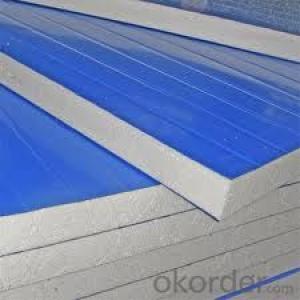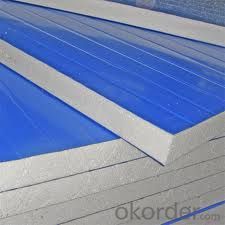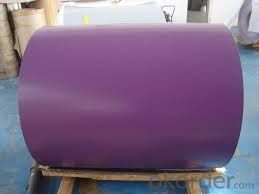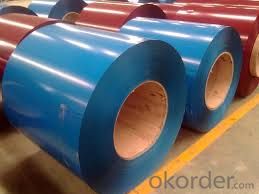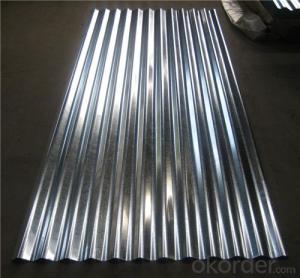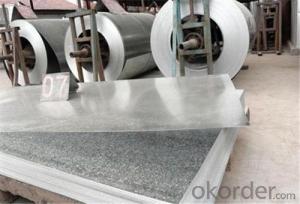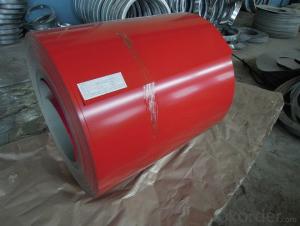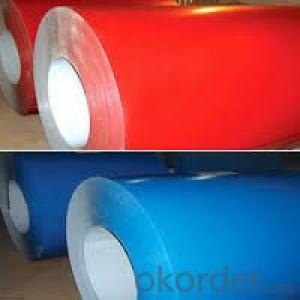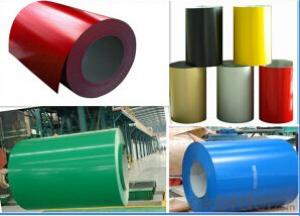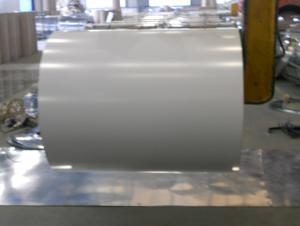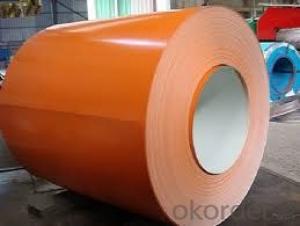Cold Rolled Steel Coil Prepainted Gi PPGI/Prepainted Steel Rolled
- Loading Port:
- Shanghai
- Payment Terms:
- TT OR LC
- Min Order Qty:
- 20 m.t.
- Supply Capability:
- 9000 m.t./month
OKorder Service Pledge
OKorder Financial Service
You Might Also Like
Product Description
PPGI sheet
1, Grade: SGCC, PPGI CGCC, SGLCC
2, Width: 800-1250mm
3, Thickness: 0.3-1.0mm
4, Color: ALL RAL
* Base Material: Al-Zn Galvanized Steel Coil. SGLCC
* Top side: 15-25 microns primer microns polyester.
* Back side: 5-8 microns primer epoxy.
* Width: 800-1, 250mm
* Thickness: 0.3 -1.0mm Thickness tolerance: +/- 0.02mm
* Al-Zn coating: 30-150g /sq. M. Or can be provided as clients' requirements
* Color: All RAL colour is available or customer supplying the sample
* Inner diameter of coil: 508mm&610mm.
* Packing: Standard seaworthy packing or according to user's need.
* Weight of each coil: 9 tons max
* Guarantee/ warranty
*Delivery time: Within 10-25 days.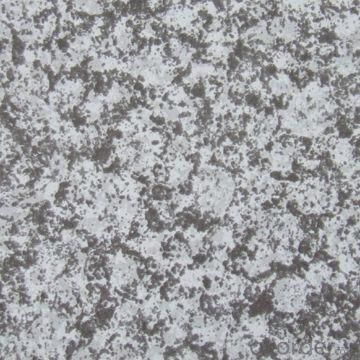
FAQ
1. Is the sample available?
Yes, samples can be sent for test if you need.
- Q: How are steel coils used in the production of metal enclosures?
- Steel coils are used in the production of metal enclosures as they provide the raw material needed for forming and shaping the enclosure. The steel coils are processed and cut into sheets or strips, which are then bent, welded, or stamped to create the desired shape and structure of the enclosure. These steel sheets offer strength, durability, and a smooth surface finish to the final product, making them ideal for manufacturing metal enclosures used in various industries such as automotive, electronics, and construction.
- Q: What is the diffrent Aluminized steel Type 1. stainless steel 409 430?
- Stainless steel 400 Series—ferritic and martensitic chromium alloys Type 409—cheapest type; used for automobile exhausts; ferritic (iron/chromium only) Type 430—decorative, e.g., for automotive trim; ferritic. Good formability, but with reduced temperature and corrosion resistance. Today, almost all bulk metal materials that are referred to loosely as aluminium, are actually alloys. For example, the common aluminium foils are alloys of 92% to 99% aluminium. Aluminized steel Type 1: 1xx.x series are minimum 99% aluminium
- Q: What are the main factors that affect the price of steel coils?
- The main factors that affect the price of steel coils are the cost of raw materials, supply and demand dynamics, production and transportation costs, changes in government policies and regulations, and global economic conditions.
- Q: How are steel coils used in the production of pipelines?
- The production of pipelines relies heavily on steel coils, which are indispensable components. These coils, crafted from top-notch steel, are utilized in the manufacturing of the pipes themselves. To initiate the process, the steel coil is unfurled and then cut into the desired size and length. The resulting pieces are then molded into cylindrical tubes through a technique known as pipe forming. Once the pipes are formed, they undergo several additional procedures to bolster their strength and durability. These may include welding, heat treatment, and coating to safeguard against corrosion. Steel coils are also employed in the creation of essential fittings and connectors required for the connection and joining of the pipes. The utilization of steel coils in pipeline production offers numerous advantages. Firstly, steel possesses exceptional strength and durability, rendering it ideal for withstanding the high pressure and stress that pipelines endure. Additionally, steel exhibits remarkable resistance to corrosion, a critical characteristic for pipelines that transport various substances like oil, gas, or water. Moreover, steel coils facilitate efficient production processes. The uniformity of the coils ensures consistent pipe dimensions, thereby facilitating easy assembly and installation. The versatility of steel allows manufacturers to customize pipes of varying sizes and specifications to meet specific project requirements. In conclusion, steel coils assume a crucial role in pipeline production. They are utilized in the creation of pipes, fittings, and connectors. The utilization of steel guarantees strength, durability, and resistance to corrosion, making it the preferred material for pipelines. Furthermore, steel coils enable efficient production processes and offer versatility in terms of customization.
- Q: Can steel coils be coated with UV-resistant materials?
- Yes, steel coils can be coated with UV-resistant materials.
- Q: Have spent two days making a specialized knife out of 304 stainless steel, after throwing into a log it bent slightly arghhhh. Is it worth continuing to finish it off or start all over again with different kind of steel if so which kind should i use.
- Sorry okorder /... I hope that link works but as you can see you dont want to use 303.304.316,410,416,430 You can get away with 301 but would be best to use 440. It kind of sounds like your a home shop guy. It would be best for you to make a knife out of a1 or d2 tool steel. with these steels you can torch heat them to a red hot heat where a magnet will not stick to them. Then let them cool slowly in the air. After that you can temper in a oven around 400f. This will a very hard long lasting knife. Check OKorder for good steel prices. A1 and D2 are not stainless but they are the best for a home shop. If you go stainless you can buy preharden material but you will have to grind everything. You can also pay someone to harden your knife but dont plan on it being cheap.
- Q: What are the different methods of cutting steel coils into sheets?
- There are several methods used to cut steel coils into sheets, including shearing, slitting, and laser cutting. Shearing involves using a straight blade to cut through the coil, while slitting uses circular blades to make multiple cuts simultaneously. Laser cutting, on the other hand, utilizes a high-powered laser beam to melt through the steel. Each method has its own advantages and is chosen based on factors such as the desired precision, speed, and cost-effectiveness.
- Q: How are steel coils used in the manufacturing of power transmission towers?
- Steel coils are used in the manufacturing of power transmission towers as they can be cut and shaped into various components such as beams, plates, and brackets. These components are then assembled to create the structure of the tower, providing strength and stability required to support the transmission lines.
- Q: What are the different methods of storing steel coils?
- There are several methods of storing steel coils, depending on the specific requirements and constraints of the storage facility. Some of the commonly used methods include: 1. Stack storage: This method involves stacking the steel coils on top of each other in a stable manner. It is a cost-effective method, as it maximizes the use of vertical space. However, it requires careful stacking to ensure stability and prevent damage to the coils. 2. Block stacking: In this method, steel coils are arranged in blocks, with each coil placed directly on top of another. The blocks are then stacked to maximize the use of space. This method provides stability and allows for easy access to individual coils. However, it may require the use of additional equipment such as coil cradles or coil saddles to prevent damage. 3. Coil cradles: Coil cradles are specialized racks or frames that are designed to hold steel coils horizontally. They provide support and prevent the coils from rolling or shifting. This method is particularly suitable for smaller coils or when quick access to individual coils is required. 4. Coil saddles: Coil saddles are U-shaped frames that are specifically designed to hold and support steel coils vertically. They are often used in conjunction with block stacking or stack storage methods. Coil saddles provide stability and prevent the coils from rolling or collapsing. 5. Coil racks: Coil racks are steel structures that are designed to hold multiple coils in an organized manner. They may have several levels or tiers, allowing for efficient use of space. Coil racks are typically used for larger coils and can be customized to accommodate specific coil dimensions. 6. Automated storage systems: In large-scale storage facilities, automated systems such as coil cranes or coil carousels may be employed. These systems use mechanical devices to transport and store steel coils, allowing for efficient and fast retrieval when needed. They are particularly useful in high-volume operations where frequent coil handling is required. It is essential to consider factors such as coil size, weight, accessibility, and environmental conditions when determining the most suitable method of storing steel coils. Additionally, proper handling, labeling, and regular inspections are crucial to ensure the integrity and longevity of the stored coils.
- Q: What are the common methods of transporting steel coils?
- The common methods of transporting steel coils include flatbed trucks, rail cars, and ocean vessels.
Send your message to us
Cold Rolled Steel Coil Prepainted Gi PPGI/Prepainted Steel Rolled
- Loading Port:
- Shanghai
- Payment Terms:
- TT OR LC
- Min Order Qty:
- 20 m.t.
- Supply Capability:
- 9000 m.t./month
OKorder Service Pledge
OKorder Financial Service
Similar products
Hot products
Hot Searches
Related keywords
